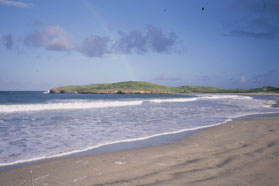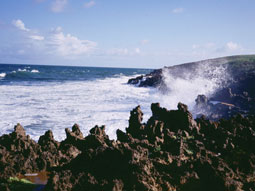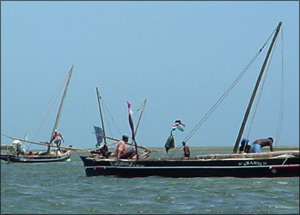


The Kiunga Marine National Reserve, on Kenya's northern coast, protects outstanding mangrove forests, sea grass beds, and coral reefs. Its beaches provide nesting sites for marine turtles, and its sea grass beds feeding grounds for the enigmatic dugong. Its offshore rock formations shelter bat roosts and support the world's largest nesting colony of roseate terns. Whale sharks, rays, whales, and dolphins cruise further out to sea. Tidal creeks, limpid lagoons, and towering dunes enrich the landscape............
The Reserve has survived intact for so long mainly because of its remoteness............much of the rest of the coast has experienced rapid human population growth, spiraling demand for marine resources and unplanned tourism development. Unregulated harvesting of fisheries and forests have outstripped rates of natural renewal, while discharges of domestic and industrial waste have overwhelmed the capacities of intertidal wetlands to absorb, dilute, and detoxify effluents.
Most of the Bajuni people living around the reserve earn their living from fishing. Traditionally they used woven traps to catch reef fish in shallow waters. But most fishermen today use highly effective -and destructive -seine nets, which catch all fish size classes indiscriminately and damage corals and sea grass beds. Larger meshed gill nets are also used-though less damaging to the substrate, they entangle and drown turtles and dugongs.
Kiunga's lobster divers traditionally use the "kimia" technique, in which the fisher spears an octopus and ties it to his spear. Lobsters shelter in the reefs in holes that have an exit route. The diver places his net over the back door and waves the octopus at the front-the lobster heads for the emergency exit and ends up in the net. Kiunga's lobster fishery supplies much of Kenya's demand. Large lobsters may attain weights of 6 kg, but increasingly smaller lobsters are being taken and concerns are emerging about sustainability, with more use being made of SCUBA as opposed to free diving and less observance of limits on berried lobsters and size classes.
Today most fishers come from outside the Reserve, and there is growing demand from commercial outfits interested in "mining" the fishery. Habitat damage and declining catches already are apparent. Left unchecked, they will diminish the biological value of the Reserve and impoverish the people most dependent on it.....